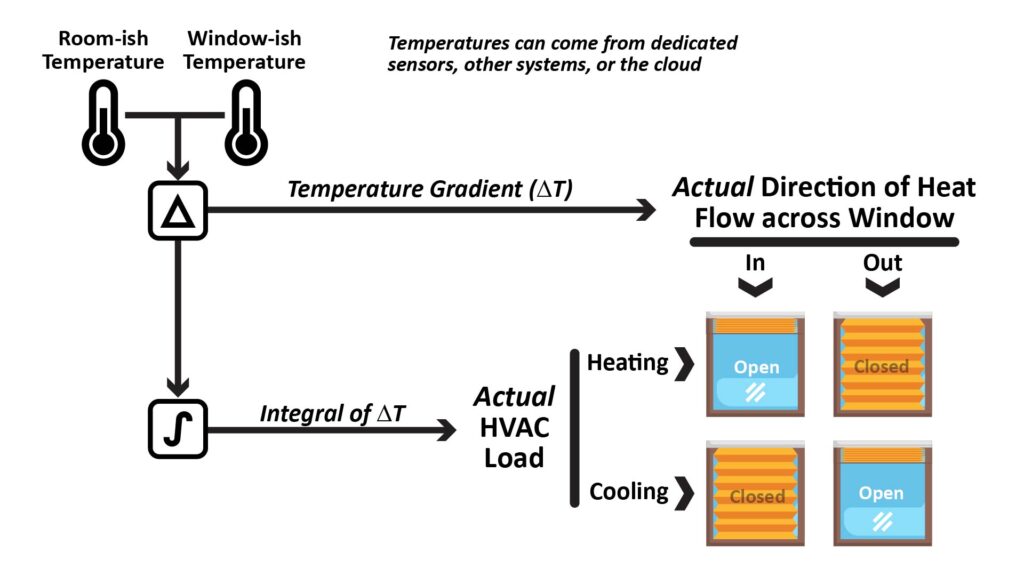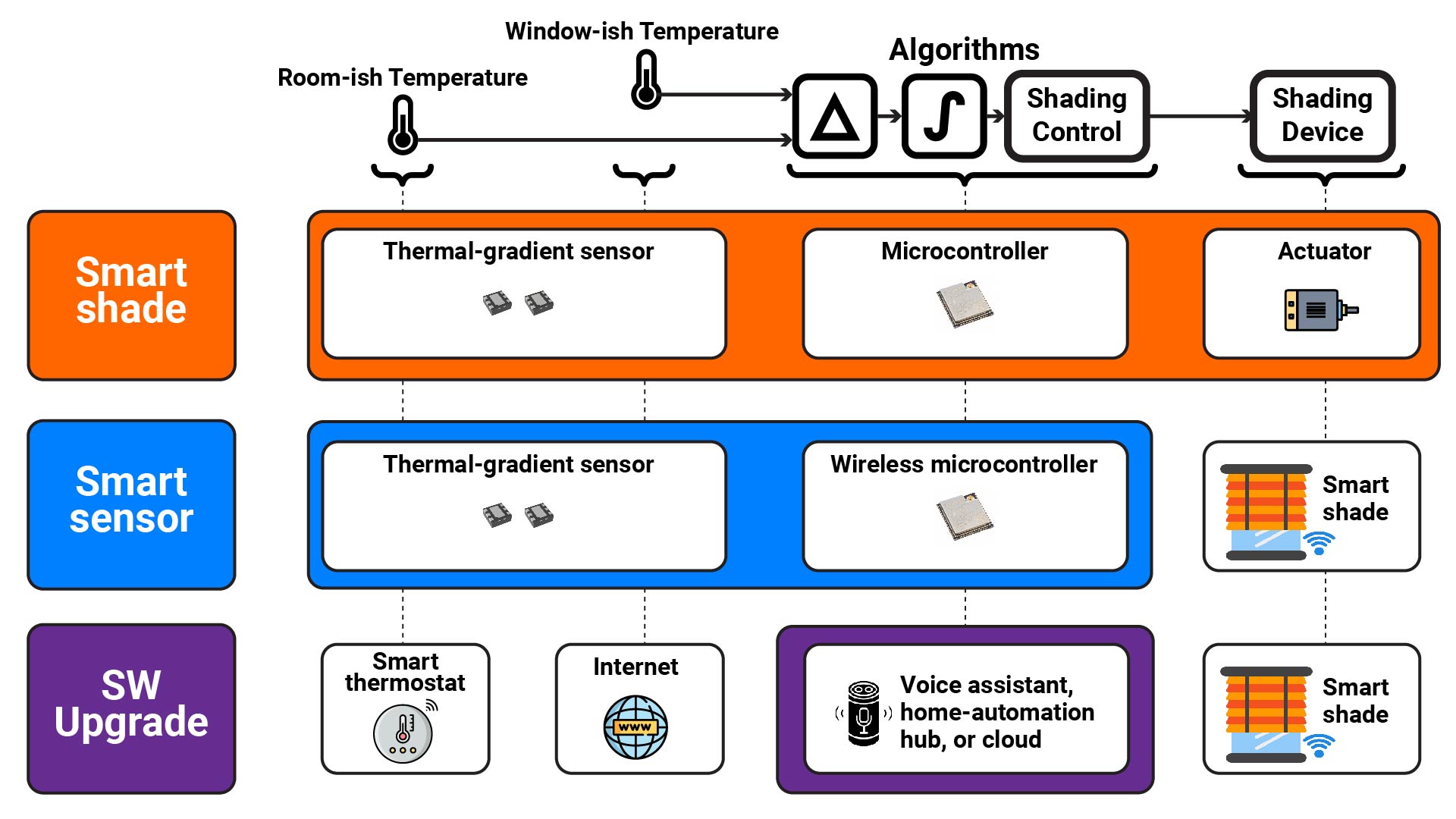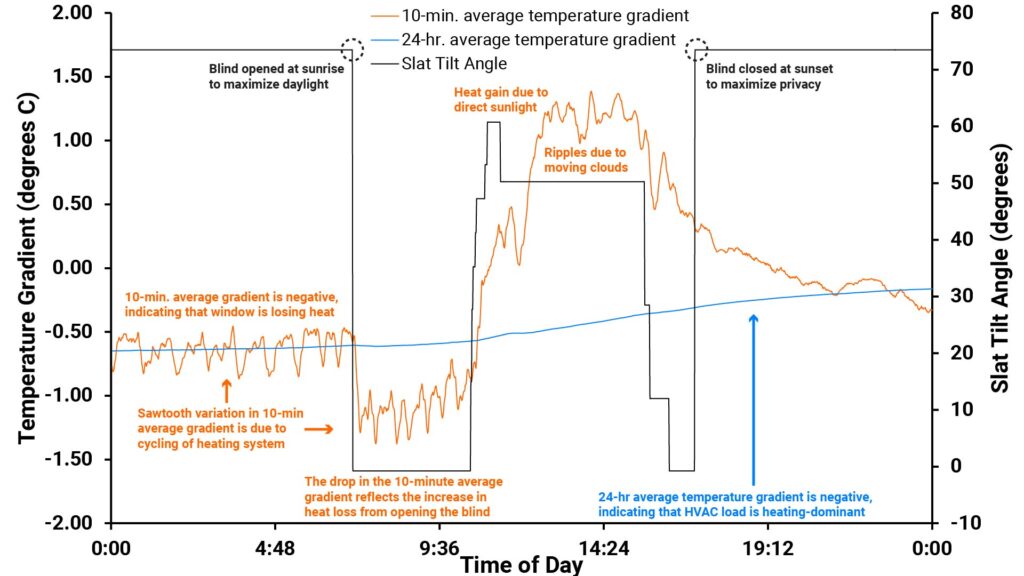Thermal Gradient Sensor and Algorithm for Automated Shading

What it does
How it works
Advantages
Product applications
Detailed Description
How Automated Shading Reduces HVAC Energy Consumption
One of the most valuable potential benefits of automated shading is energy savings via reduced HVAC loads. This is possible because adjustable window coverings can vary both the thermal transmittance (i.e. the U-value) and the Solar Heat Gain Coefficient (SHGC) of a host window.
Minimizing HVAC loads with an adjustable shading device involves either fully opening or fully closing the device, depending on two variables: the direction of heat flow across the window, and the function being performed by the HVAC system (either heating or cooling):

Of course, these HVAC-driven shading settings can be inconsistent with a user’s preferred setting (e.g. to main privacy, provide natural illumination, or block glare), so HVAC-driven operation is typically appropriate only in unoccupied spaces or at nighttime with the lights off. An especially apt application for HVAC-driven automated shading is in partially occupied office buildings.
The Problem with Conventional Automated Shading Technology
The conventional approach to implementing the shading-setting algorithm summarized in Figure 1 is to infer the direction of heat flow through the window on the basis of the outside temperature, and to determine the HVAC operating mode by “talking” to the HVAC system:

This conventional approach has significant limitations.
First, the actual exterior temperature outside the window can differ substantially from the local temperature obtained from a weather service (or from a building management system), which means that the inferred direction of heat flow across the window can be incorrect.
Second, the HVAC system might not have a communications interface that’s compatible with the shading system, or it might not be capable of proving mode information at all. Further, even if the HVAC and shading systems are interoperable, the HVAC operating mode will not necessarily be consistent with actual heat load in the area in which the window is located. For example, the HVAC system can be operating in the heating mode even though the windowed area is experiencing a net heat gain over time.
Finally, the need for connectivity to the internet and HVAC system can present cost and security issues in some applications, such as retrofit automated shading in office buildings.
Our Solution
Our patented solution is based on the fact that the actual direction of heat flow across a window is indicated by the sign of the temperature gradient normal to the window surface, and that the actual HVAC load in the windowed area is indicated by the sign of the integrated (time-averaged) temperature gradient.
Our approach involves obtaining the difference between two temperature values:
- A window-ish temperature is a temperature closer to the window temperature than to the room’s core temperature (at the same distance from the ceiling). It can be obtained via an actual sensor at or near the window, or (less preferably) it can be assumed to be the same as the external temperature obtained from a weather server.
- A room-ish temperature is a temperature closer to the room’s core temperature than to window temperature (at the same distance from the ceiling). It can be obtained via a dedicated sensor, or by applying a fixed offset to the actual room temperature (to account for thermal stratification) obtained via an interface to the HVAC system or a Smart Thermostat. Alternatively, in many applications, an assumed room temperature can be used with minimum impact on performance.

The magnitude of the temperature gradient varies with proximity to the window surface. Relatively close to the window surface, the gradient is large enough that a useful indication of the heat flow can be obtained with a thermal gradient sensor consisting of two precision temperature-sensing chips separated by as little as 2 cm. Such a thermal gradient sensor can be integrated into a variety of products intended to be mounted at or near the window, as described below under Applications.
Not only does such a sensor provide the most reliable indication of the actual direction of heat flow across the window, it also completely eliminates the need for temperature information from external sources.
Regardless of how the thermal gradient signal is obtained, the algorithm used to process the signal requires only a tiny fraction of the processing capacity of even the least expensive microcontrollers. It can therefore be implemented by virtually any smart shading product, as well as by a voice assistant, home-automation hub, building-management system, or cloud server.
Thus, in addition to saving more HVAC energy than the conventional approach of Figure 2, our approach is potentially far simpler to implement.
Applications
Our thermal-gradient sensing technology is potentially applicable to any automated shading system intended to reduce HVAC energy consumption, whether in residential or commercial buildings. For example, one potential application is to reduce HVAC loads in temporarily unoccupied spaces in partially occupied office buildings.
Our technology can be implemented using a combination of hardware and algorithms, or purely via algorithms in conjunction with existing hardware. This enables it to be inserted into a wide variety of product types. Three exemplar applications are shown in Figure 4:

Smart Blind or Shade
The first application shown in Figure 4 is a smart blind or shade which integrates both the sensor and the algorithms. This enables a fully self-contained capability for responsive thermal control by eliminating the need for a wired or wireless interface to an HVAC system, smart thermostat, or source of weather information. This reduces cost, minimizes power consumption (for battery or solar-charged operation), avoids interoperability issues, and minimizes cyber risks.
An example of a device providing such a self-contained thermal control capability is our IntelliBlind™ Smart Blind Actuator. While the IntelliBlind™ reference design does include a wireless microcontroller, it also has an integrated thermal gradient sensor and algorithms which enable it to perform responsive thermal control without wireless connectivity, when the situation calls for it.
The IntelliBlind™ thermal gradient sensor exploits the fact that the temperature of the host blind’s metal headrail is closer to the window temperature than to the room temperature. Specifically, the gradient sensor provides a high-conductivity thermal path between one of two temperature sensors and the headrail mounting magnet, while the other temperature sensor is thermally isolated from the mounting magnet:

This enables effective sensing of the thermal gradient due to heat transfer across the window—despite the fact that the two sensors are coplanar on the same printed-circuit board and only a few centimeters apart. The following figure shows an example of the sensor outputs on a sunny winter day in the metro-DC area:

Note that the gradient sensor readily senses the heat flow through the window: the ripples in the 10-minute average gradient due to cycling of the heating system are apparent, as is the sharp drop in the gradient when the blind opens at sunrise.
By the way, the room was occupied from sunrise through sunset when the data of Figure 6 were collected, so IntelliBlind™ was performing responsive daylight control (instead of thermal control) during the daylight hours to maximize glare-free daylight. If the room had been empty during the daytime, IntelliBlind™ would have been performing thermal control instead, in which case it would have kept the blind fully closed until the onset of direct sunlight in order to minimize the load on the HVAC system.
Smart Sensor
The second application shown in Figure 4 is a smart sensor that can be used to add responsive thermal control capability to an ordinary automated shading product. If mounted in proximity to a window, such a sensor can obtain a useful thermal gradient signal with relatively closely spaced sensors (as is the case with IntelliBlind™ shown above).
We’ve developed reference designs for two such smart sensors, which we call IntelliLux™ Smart Sensors: the IntelliLux™ Window Sensor (intended for direct mounting to the window glazing) and the IntelliLux™ Headrail Sensor (which incorporates the same sensor functionality as IntelliBlind™ shown above):

Both sensors include a multi-protocol wireless microcontroller which implements a low-power RF protocol, implements the algorithm of Figure 3, and communicates HVAC-optimized shading settings to a conventional Smart Shade product. Both also incorporate our multi-spectral glare sensor for responsive daylight control, as well as a small photovoltaic panel, supercapacitor, and energy-harvesting controller to eliminate the need for batteries.
Software Upgrade to Conventional Automated Shading System
The third application shown in Figure 4 is an algorithm-only implementation of the approach of Figure 3 that does not require a dedicated thermal gradient sensor.
Instead, the thermal gradient is obtained as the difference between the room temperature (from a connected smart thermostat) and the outside temperature (from a connected weather server), with an optional offset to account for temperature stratification. If a smart thermostat is not available, an assumed room temperature can be used instead of the actual room temperature.
The algorithm time-integrates the thermal gradient over at least 24 hours to obtain the daily average gradient, determines the optimum shading settings per Figure 3, and sends the appropriate shading commands to the connected Smart Shade.
The algorithm can be hosted on the Smart Shade’s microcontroller, in a local home automation hub, or in the cloud.
